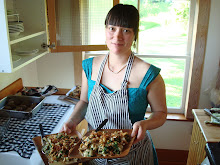 freefoto.com
freefoto.com"It was all about succotash. He said that succotash was made with lima beans and she said that succotash was made with string beans, and there you are."
-origin unknown
The definition and understanding of succotash depends on from where and when you are. The word succotash is derived from the Narragansett Indian word msakwitash meaning fragments or boiled corn. From this dish of Native American origin, succotash was born into, and survived centuries of interpretation and localization.
The poor man's staple of corn and beans that was popular during the Great Depression, had its roots in colonial adaptation, which had its roots in first peoples' wild food sources.
In every step people utilized what they had and made of it what they knew, depending on the times. The Holly Grove Farm puts it well - "each version of succotash may tell a story......What ever the case may be, it is a plate of cultural anthropology, a taste of history." They go on to give a recipe for Creole succotash with okra.
The only essential ingredient of succotash is fresh corn cut off the cob, and beans (green, dried shell, lima) cooked along with other "fragments" - old recipes usually included onions, salt pork or bear fat, and possibly squash or other meat. In The Story of Corn by Betty Harper Fussel, Zuni succotash is described thickened with ground sunflower seeds or pinon nuts, and in Native Harvests by Barrie Kavasch succotash is simmered with nut butter. During the Great Depression succotash was commonly topped with pastry and baked into a pie. We even have an insipid version found in every American grocery store freezer. Other evolutions- dried corn, sweet or hot peppers, cream, maple syrup, fresh peas, sweet potatoes, tomatoes, summer squash, leeks, fresh herbs, even curry and coconut, and of course, mushrooms.
My personal story of succotash involves wild mushrooms. I find myself coming back again and again to this basic formula - corn, sweet onions, mushrooms. The standard bean component has been replaced or augmented with mushrooms. In some ways wild mushrooms are woven into the story of my whole life and with the question - Why wild mushroom succotash? - you would get an answer years long.
Whether okra or lima beans or green beans or mushrooms, "there you are" sustaining yourself with what is fresh, locally available, and preferred by your taste buds or cultural conventions, eating a dish that connects you to our collective evolving history.

Use the recipe below as a guideline to make your own variations of, or rather evolutions on, the succotash theme. Meaty lobster mushrooms are great substitutes for chanterelles. Yesterday I made a version with lobsters, cippollinis, corn and purlsane tossed in at the end (no beans). Thick purslane leaves hold up nicely in warm dishes.
This recipe is from The Illustrated Wild Foods Recipe Calendar 2009.
Summer Chanterelle Succotash
The chanterelles of late summer are smaller, firmer and drier than the fall harvest, and this recipe takes advantage of those qualities, along with other delicious bounty found in the farmers market during August. Serve this atop grilled salmon or a juicy pork chop. Or with fresh cooked shell beans, such as cranberry, tossed in the mix.
1 pound fresh cippollini or Walla Walla or other sweet onion
2 tbsp olive oil
2 tsp salt
3 ears sweet corn
4 tbsp unsalted butter
¾ lb small chanterelles, cleaned, and halved if big
½ lb romano green beans, cut on diagonal in thirds, and blanched in salted water
1 pint cherry tomatoes, halved
1 lemon, zest and juice
½ cup basil, slivered
Heat oven to 325˚F. Cut onions into medium wedges and place in baking dish. Toss wedges with 1 tsp salt, a few grindings of pepper and olive oil. Bake for 30 minutes, stirring once or twice. Meanwhile, cut corn off cob and scrape the cob with a knife or spoon to get the all the corn milk left behind. In a large skillet heat 2 T butter over medium high heat. Add chanterelles, 1 tsp salt, and a few grindings of pepper. Sauté until tender and liquid has evaporated. Turn heat down to medium and add corn, continue cooking until heated through. Add romano beans, baked onions with all their juices, the lemon zest, half the lemon juice and the remaining butter. Heat through for a few minutes. Turn off heat and add tomatoes and basil. Taste and adjust seasonings and lemon juice.




No comments:
Post a Comment